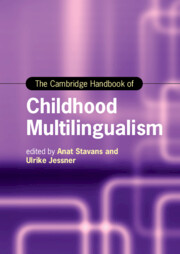Book contents
- The Cambridge Handbook of Childhood Multilingualism
- Cambridge Handbooks in Language and Linguistics
- The Cambridge Handbook of Childhood Multilingualism
- Copyright page
- Contents
- Figures
- Tables
- About the Editors
- Contributors
- Acknowledgments
- Multilingualism Is Not Bilingualism +1: An Introduction
- Part One Becoming and Being a Multilingual Child
- Part Two Cognition and Faculties in Multilinguals
- 5 Language and Thought in Multilingual Children
- 6 Multilingual Exposure and Children’s Effective Communication
- 7 Metalinguistic Awareness and Early Multilingual Learning
- 8 Code-Switching among Bilingual and Trilingual Children
- 9 Children’s Perception of Their Multilingualism
- 10 Multilingualism and Language Play
- Part Three Family Language Policy
- Part Four Language(s) and Literacy of Multilingual Children through Schooling
- Part Five Socialization in Childhood Multilingualism
- Part Six Multilingual Children’s Landscape
- Subject Index
- Country Index
- Language Index
- References
6 - Multilingual Exposure and Children’s Effective Communication
from Part Two - Cognition and Faculties in Multilinguals
Published online by Cambridge University Press: 18 August 2022
- The Cambridge Handbook of Childhood Multilingualism
- Cambridge Handbooks in Language and Linguistics
- The Cambridge Handbook of Childhood Multilingualism
- Copyright page
- Contents
- Figures
- Tables
- About the Editors
- Contributors
- Acknowledgments
- Multilingualism Is Not Bilingualism +1: An Introduction
- Part One Becoming and Being a Multilingual Child
- Part Two Cognition and Faculties in Multilinguals
- 5 Language and Thought in Multilingual Children
- 6 Multilingual Exposure and Children’s Effective Communication
- 7 Metalinguistic Awareness and Early Multilingual Learning
- 8 Code-Switching among Bilingual and Trilingual Children
- 9 Children’s Perception of Their Multilingualism
- 10 Multilingualism and Language Play
- Part Three Family Language Policy
- Part Four Language(s) and Literacy of Multilingual Children through Schooling
- Part Five Socialization in Childhood Multilingualism
- Part Six Multilingual Children’s Landscape
- Subject Index
- Country Index
- Language Index
- References
Summary
This chapter discusses the possible cognitive and socio-cognitive benefits children may enjoy due to multilingualism. We argue that children acquire advanced communication skills through everyday engagement in multilingual interaction with their family members and surroundings from the earliest stages of development. We outline the major findings on the nature of multilingual language development, parental input, and parent–child interactions in multilingual families to understand the context in which multilingual children may acquire their assumed advanced abilities in communication. We provide an extensive overview of current research scrutinizing the abilities multilingual children develop in the earliest years of life. This review covers cases of multilingual first language acquisition, which refers to the acquisition of two or more languages from before the age of 3, a cut-off age used to distinguish between simultaneous and successive development of multiple languages. The review draws on studies from both bilingual and multilingual (trilingual) first language acquisition, as many of the studies of bilingual children preceded those of multilingual children and can give meaningful insight into multilingual development.
Keywords
- Type
- Chapter
- Information
- The Cambridge Handbook of Childhood Multilingualism , pp. 141 - 162Publisher: Cambridge University PressPrint publication year: 2022



